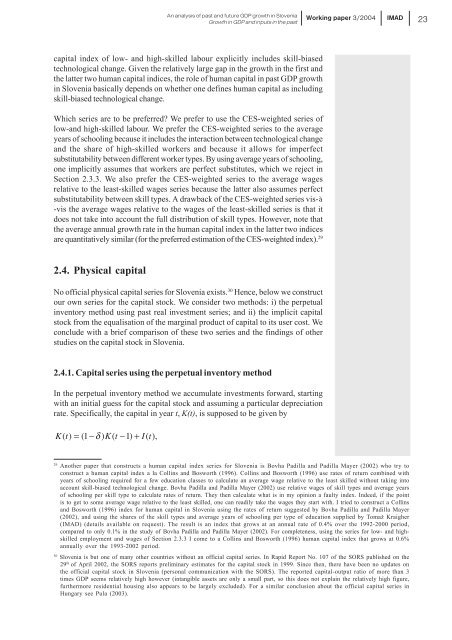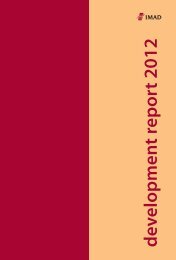Working papers published by IMAD ISSN: 1318-1920 ... - UMAR
Working papers published by IMAD ISSN: 1318-1920 ... - UMAR
Working papers published by IMAD ISSN: 1318-1920 ... - UMAR
You also want an ePaper? Increase the reach of your titles
YUMPU automatically turns print PDFs into web optimized ePapers that Google loves.
An analysis of past and future GDP growth in Slovenia<br />
Growth in GDP and inputs in the past<br />
<strong>Working</strong> paper 3/2004<br />
<strong>IMAD</strong><br />
23<br />
capital index of low- and high-skilled labour explicitly includes skill-biased<br />
technological change. Given the relatively large gap in the growth in the first and<br />
the latter two human capital indices, the role of human capital in past GDP growth<br />
in Slovenia basically depends on whether one defines human capital as including<br />
skill-biased technological change.<br />
Which series are to be preferred? We prefer to use the CES-weighted series of<br />
low-and high-skilled labour. We prefer the CES-weighted series to the average<br />
years of schooling because it includes the interaction between technological change<br />
and the share of high-skilled workers and because it allows for imperfect<br />
substitutability between different worker types. By using average years of schooling,<br />
one implicitly assumes that workers are perfect substitutes, which we reject in<br />
Section 2.3.3. We also prefer the CES-weighted series to the average wages<br />
relative to the least-skilled wages series because the latter also assumes perfect<br />
substitutability between skill types. A drawback of the CES-weighted series vis- à<br />
-vis the average wages relative to the wages of the least-skilled series is that it<br />
does not take into account the full distribution of skill types. However, note that<br />
the average annual growth rate in the human capital index in the latter two indices<br />
are quantitatively similar (for the preferred estimation of the CES-weighted index). 29<br />
2.4. Physical capital<br />
No official physical capital series for Slovenia exists. 30 Hence, below we construct<br />
our own series for the capital stock. We consider two methods: i) the perpetual<br />
inventory method using past real investment series; and ii) the implicit capital<br />
stock from the equalisation of the marginal product of capital to its user cost. We<br />
conclude with a brief comparison of these two series and the findings of other<br />
studies on the capital stock in Slovenia.<br />
2.4.1. Capital series using the perpetual inventory method<br />
In the perpetual inventory method we accumulate investments forward, starting<br />
with an initial guess for the capital stock and assuming a particular depreciation<br />
rate. Specifically, the capital in year t, K(t), is supposed to be given <strong>by</strong><br />
K ( t)<br />
= (1 −δ<br />
) K(<br />
t −1)<br />
+ I(<br />
t),<br />
29<br />
Another paper that constructs a human capital index series for Slovenia is Bovha Padilla and Padilla Mayer (2002) who try to<br />
construct a human capital index a la Collins and Bosworth (1996). Collins and Bosworth (1996) use rates of return combined with<br />
years of schooling required for a few education classes to calculate an average wage relative to the least skilled without taking into<br />
account skill-biased technological change. Bovha Padilla and Padilla Mayer (2002) use relative wages of skill types and average years<br />
of schooling per skill type to calculate rates of return. They then calculate what is in my opinion a faulty index. Indeed, if the point<br />
is to get to some average wage relative to the least skilled, one can readily take the wages they start with. I tried to construct a Collins<br />
and Bosworth (1996) index for human capital in Slovenia using the rates of return suggested <strong>by</strong> Bovha Padilla and Padilla Mayer<br />
(2002), and using the shares of the skill types and average years of schooling per type of education supplied <strong>by</strong> Tomaž Kraigher<br />
(<strong>IMAD</strong>) (details available on request). The result is an index that grows at an annual rate of 0.4% over the 1992-2000 period,<br />
compared to only 0.1% in the study of Bovha Padilla and Padilla Mayer (2002). For completeness, using the series for low- and highskilled<br />
employment and wages of Section 2.3.3 I come to a Collins and Bosworth (1996) human capital index that grows at 0.6%<br />
annually over the 1993-2002 period.<br />
30<br />
Slovenia is but one of many other countries without an official capital series. In Rapid Report No. 107 of the SORS <strong>published</strong> on the<br />
29 th of April 2002, the SORS reports preliminary estimates for the capital stock in 1999. Since then, there have been no updates on<br />
the official capital stock in Slovenia (personal communication with the SORS). The reported capital-output ratio of more than 3<br />
times GDP seems relatively high however (intangible assets are only a small part, so this does not explain the relatively high figure,<br />
furthermore residential housing also appears to be largely excluded). For a similar conclusion about the official capital series in<br />
Hungary see Pula (2003).
















